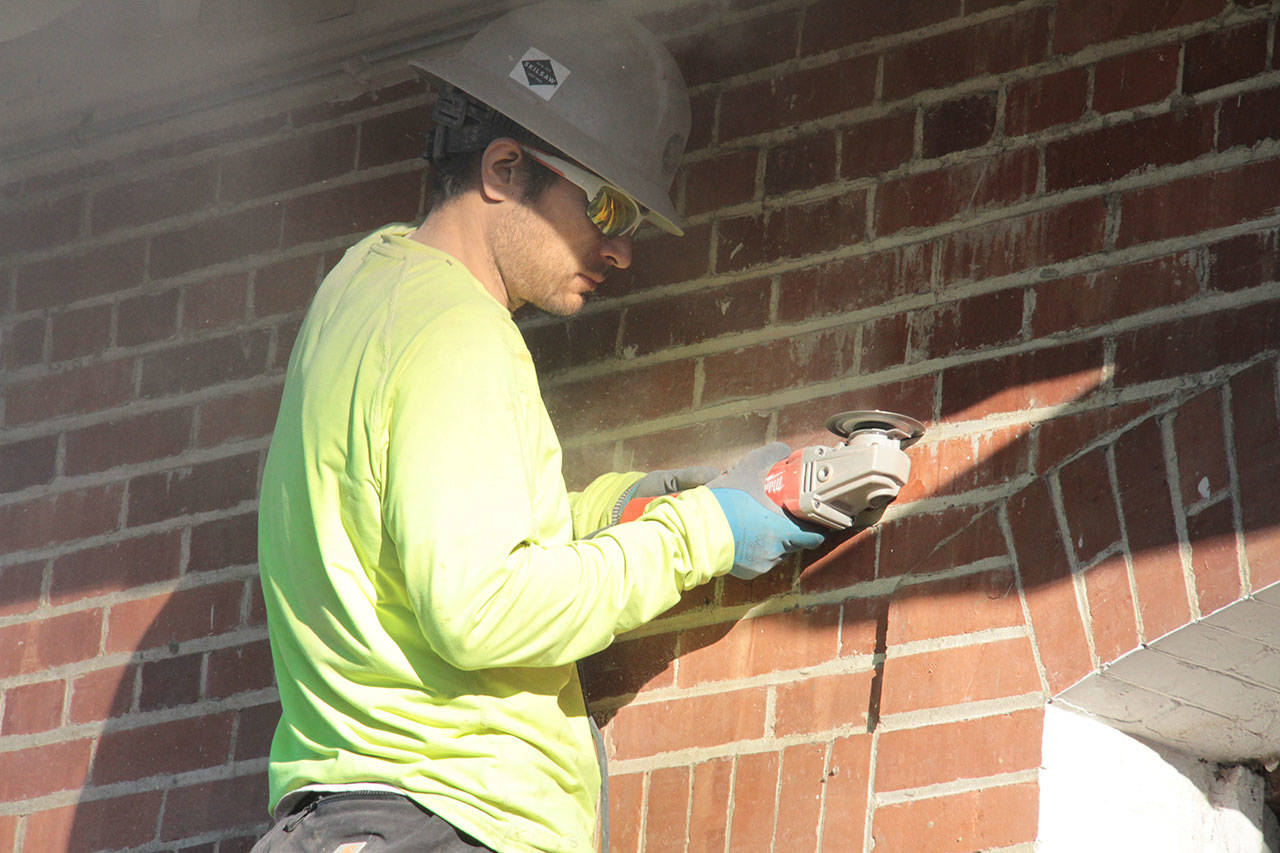The Fort Ward Community Hall project has hit a major milestone.
And this one’s made of mortar.
A masonry team from Masonry Restoration Consulting in Lake Stevens has been at the Fort Ward bakery building since early November, helping to restore the facade of the historic building to its former glory.
The team of masons recently removed bricks that have blocked some of the building’s windows and doors for 75 years or so, and are working their way through a complete refurbishment of the structure’s stonework.
“It’s a pretty comprehensive restoration of the masonry of the building,” explained Doug Crist of the Friends of Fort Ward, the all- volunteer, nonprofit organization that’s dedicated to historical preservation in the Fort Ward neighborhood. “We’re taking it back to what it’s supposed to look like.”
Reopening the windows and doors, and restoring the brick facade, is a monumental moment for the project, Crist said.
“After talking about this and raising money for three years … it’s actually underway,” he added. “Things are happening. We are knee-deep in dust, and that’s a sign of progress.”
The bakery was built in 1910 as part of the construction of Fort Ward for the U.S. Army Coast Artillery Corps.
Fort Ward was part of the coast defense network that protected the Puget Sound Naval Shipyard, along with Fort Worden in Port Townsend, Fort Casey on Whidbey Island, and Fort Flagler on Marrowstone Island.
But after the Army abandoned the fort in the late 1920s, the Navy reopened it in 1938 as Naval Radio Station Bainbridge Island. The Navy had different plans for the bakery building, however.
“These windows had been filled in by the Navy, sometime in the 1940s when they turned this from a bakery into a power station,” Crist said as he recently led an impromptu tour of the building.
Restoration of the bakery — a partnership project between the Friends of Fort Ward, the Bainbridge Island Metropolitan Park & Recreation District, and Kitsap County (Fort Ward) Sewer District No. 7 — started in March.
“These windows — they haven’t let light in for 75 years. So getting those unbricked and opened up, that’s definitely a milestone,” he said.
The team of masons has also been removing damaged bricks and mortar from the bakery’s walls, and digging out and replacing mortar where it’s been compromised.
It’s a painstaking, hammer-and- chisel process, and one that’s being guided by the Secretary of Interior’s Standards for the Treatment of Historic Properties. Bricks being removed from blocked windows and doors have been stacked inside the bakery for reuse, such as filling in where other bricks are missing, as well as plugging a random hole that was punched in one wall, probably for a dryer vent after the building was sold and converted to a private home in 1960.
“It’s a meticulous job,” Crist said of the masonry work, and a big component of the project in terms of money and time.
“But you would expect that; it’s a brick building and its brickness defines what it is. Spending a lot of time and care refurbishing it and restoring it — it makes sense, given it’s the essence of the structure.”
Beyond the complete refurbishment of the bakery’s masonry, the team will also be cleaning, rebuilding and replacing damaged areas and sandstone lintels.
The work should be finished by spring, he said.
“It’s going fairly quickly, without too many surprises,” Crist said.
Other work to come includes installing period-correct double-hung windows and five-panel doors.
Some of the pieces to be installed are authentic, Crist noted. Original doors to the building were found in someone’s garden shed in the neighborhood, and some of the bakery’s old windows were found in a nearby garage.
Another set of original, oversized doors were found in the crawl space of the bakery, underneath a raised floor that was installed after the bakery became a home.
“Things will continue to happen fairly rapidly now. We’ll get our order for windows and start getting those installed,” Crist said.
The area next to the building will be turned into a parking lot, and interior work will move to the rafters.
Port Madison Wood Floors is donating all of the materials for a new hardwood floor for the bakery’s main room, Crist said.
The restoration plan also involves plumbing and electrical work, and the installation of a new restroom, kitchen, and heating and lighting systems, as well as landscaping.
Once the renovation project is complete, the building will serve as a community center — something the south end has never had.
While other areas of Bainbridge have had historical halls — Seabold Hall, Island Center, and Camp Yeomalt near Winslow, “the south end has never had its own,” Crist said. “And so filling that void, filling that need, has been a primary goal of this project.”
Kitsap County (Fort Ward) Sewer District No. 7 bought the bakery building with a community hall project in mind.
But it’s taken the support of Bainbridge to bring it into reality.
“We should really thank the community for sticking with us this long and getting us this far,” Crist said. “When we started talking about this in 2014/2015, it was kind of a concept, an idea, and a dream.
“It took faith for people to buy into this, and buy into the idea and send money our way. But the community has been extraordinarily supportive, and now we’re at the point where we’re close to rewarding their faith with a new community building that everyone’s going to enjoy.”
With the restoration project in full swing, the Friends of Fort Ward are making their final fundraising push for contributions through the One Call for All campaign.
“This is part of our architectural heritage and it’s part of our military heritage. It’s part of our community heritage,” Crist said. “And we’re able to observe it and restore it and give it another hundred years.”



